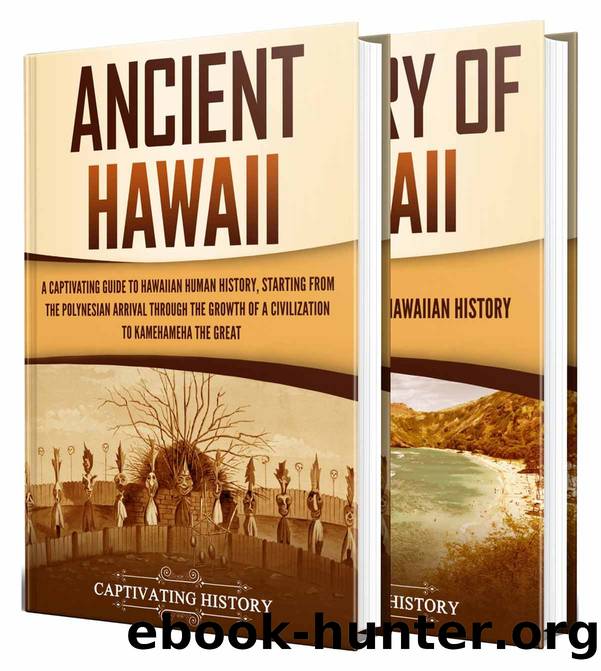Hawaiian History: A Captivating Guide to the History of the Big Island, Starting From Ancient Hawaii to the Present by History Captivating

Author:History, Captivating
Language: eng
Format: epub
Published: 2022-02-07T00:00:00+00:00
An artistâs depiction of a Hawaiian woman pounding natural fibers to make the clothes they use to dress themselves, 1819. (Source: Wikimedia Commons, Hiart. Original work by Jacques Etienne Victor Arago, Honolulu Museum of Art)
Coconut plants would have multiple uses, from building timber to starting fires to creating ropes, which were spun from its fibers. The nutritional content of the coconut also meant that most ancient Polynesians treasured the coconut tree for all its uses, earning it the nickname of âthe tree of life.â Other plants that ancient Polynesians and Hawaiians would bring along with them included bananas, breadfruit, and Polynesian arrowroot.
Ancient Life
Ancient Hawaiians almost definitely had an agrarian lifestyle and possessed a complex, communal society that included caste systems. The highest rung consisted of chiefs and leaders of villages and regions. Priests, shamans, healers, and professional craftsmen made up the majority of the second rung of the caste system, followed by the common people who made up most of the population. It is also very likely that even in ancient Hawaiʻi, society was organized around the concept of an extended family unit, the ohana. This unit was very important to ancient Hawaiians because it was connected to their caste system, the ruling class, genealogical naming of family gods, and even the ownership of land. Further kinship groups would develop from the ohana, and aggregations of these would then form villages or inhabit a region. The overall task of the ohana was to cultivate, find, hunt, or harvest food and other raw materials, whether from agricultural or marine sources. These would be used to sustain both the ohana and the larger group that it belonged to, along with other requirements of trading, levies, religious offerings, and more.
Although ancient Hawaiian agriculture was not as advanced as other mass-producing agricultural civilizations, it was nonetheless systematic and reliable enough to not only maintain an adequate supply of food but also to grow the population at a steady rate. Such a feat was accomplished not with metal tools or animal-driven implements but rather with a system of work allocation and group effort. There is also evidence of more advanced agricultural constructions and aquaculture practices dating back to the ancient Hawaiians. Freshwater ponds and multilevel terraces were constructed to help crops like taro and sweet potato to grow and flourish.
Meat from swine and fowl would serve only as supplementary food sources and not as the main staples of everyday life. Hunting would very likely be carried out simultaneously alongside gathering, with the activity being one that involved the entire family. Similarly, fishing and marine resource collection was a family affair, especially in the shallower coastal areas. Deepsea fishing would only be done by specialists, as they had to employ large canoes, deep-sea fishing lines, spears, nets, and expert diving and swimming techniques. Old records of oral histories of ancient Hawaiʻi tell of fleets of canoes going out to sea with many men in a massive effort to catch fish and other marine life. The people
Download
This site does not store any files on its server. We only index and link to content provided by other sites. Please contact the content providers to delete copyright contents if any and email us, we'll remove relevant links or contents immediately.
| Administration | Assessment |
| Educational Psychology | Experimental Methods |
| History | Language Experience Approach |
| Philosophy & Social Aspects | Reform & Policy |
| Research |
The Art of Coaching Workbook by Elena Aguilar(50991)
Trainspotting by Irvine Welsh(21520)
Twilight of the Idols With the Antichrist and Ecce Homo by Friedrich Nietzsche(18507)
Fangirl by Rainbow Rowell(9099)
Periodization Training for Sports by Tudor Bompa(8171)
Change Your Questions, Change Your Life by Marilee Adams(7637)
This Is How You Lose Her by Junot Diaz(6796)
Asking the Right Questions: A Guide to Critical Thinking by M. Neil Browne & Stuart M. Keeley(5650)
Grit by Angela Duckworth(5525)
Red Sparrow by Jason Matthews(5391)
Paper Towns by Green John(5092)
Room 212 by Kate Stewart(5040)
Ken Follett - World without end by Ken Follett(4646)
Housekeeping by Marilynne Robinson(4349)
The Sports Rules Book by Human Kinetics(4297)
Double Down (Diary of a Wimpy Kid Book 11) by Jeff Kinney(4208)
Papillon (English) by Henri Charrière(4199)
The Motorcycle Diaries by Ernesto Che Guevara(4016)
Exercise Technique Manual for Resistance Training by National Strength & Conditioning Association(3957)
